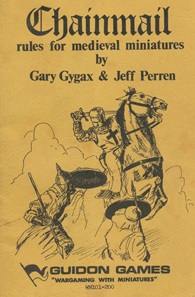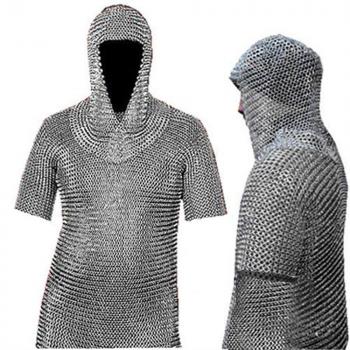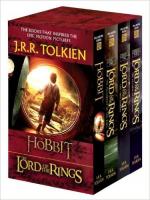Initiative in Chainmail
Introduction
Before Dungeons & Dragons was created, Gary Gygax, with Jeff Perren, created a rule book named «Chainmail, rules for medieval miniatures» that they started selling in 1971.
This was a concept that was born from wargames in a setting that was in medieval time, and later included fantasy creatures such as trolls and goblins (the first version only had humans).
The game actually has many wargame like features in its combat mechanisms. It described several types of combats to resolve fights depending on what was happening.
Initiative was a concept that was already included in this game, although it was not defined in a way that was similar to what we have in Dungeons & Dragons.

Combat in Rules for Medieval Miniatures
As mentioned earlier, the book includes various types of combat. It was for a wargame type of setting where you had a large table with hills and rivers and miniatures fighting... wars.
In a wargame, a figure generally represents forces rather than one specific character or monster. So the figure of a dragon could represents 3 dragons and the figure of a soldier could represent 50 people in armor.
The Rules for Medieval Miniatures fall in this category where multiple people represent a force and fight against another force.
The Turn Sequence
This sequence actually defines an Initiative Roll.
Both sides roll a 1d6 and the one with the highest score decides whether to move now or after his opponent, it is also given the opportunity to fire against the opponent at that time.
The other party would then move and that's when the first party could counter-move (if it did not move first).
At that point artillery fire can be taken, followed by missile fire, and melee are resolved.
There are two types of moves: regular and split-move. In split-move, you can fire missiles while doing your split move, otherwise the other fighting is always resolved as if it were to happen simultaneously on both sides.
In other words, all roll dice and calculate their damage to their enemy, then all calculate their current level of health. Once the health reaches zero, that unit is removed from the board, they're all dead.
Simultaneous Movement and Fighting
When the 1d6 roll is the same for both parties, then the special simultaneous movement and combat rules apply. In that case both parties write down what they are to do on that turn. Once ready resolution is checked for both parties.
To ease resolution in a game, the gamers could have a referee. A (mostly) neutral person that does not have forces involved in that combat.
Fighting methods
This method using a 1d6 Initiative Roll was for forces fighting with:
- Charge: Swiss/Landsknechte Pike, Cavalry
- Missile: Crossbows, Bows, Javelins, Axes, Spears.
- Catapult
- Gunpowder Weapons: Arquibusiers, Cannon
- Melee
- Siege
- Ladders (when attacking a castle or other fortress)
- Boiling Oil
- Rocks
- Mines
Man-to-Man Combat
The rules introduced an interesting concept, when you think about it, since a wargame pretty much always includes forces: a group of people of one kind (unless your a Viking) that team together and go fight. So a one on one combat sequence did not seem to make sense in that setting. Yet, they introduced that method of combat in this book.
The movement and fighting concepts as presented earlier would apply to the Man-to-Man Combat unless something said otherwise in this section.
No Initiative for Man-to-Man Combat
For the Man-to-Man Combat, you would not roll Initiative. Instead the rules stated that the person who started the fight would attack first. An interesting idea!? Although there were two exceptions: if the adversary had a weapon two classes higher (i.e. longer) then the adversary (defender) would start. Also a defender fighting from above would roll the first blow instead of the attacker.
Further rounds continue on in the same order unless one of the opponents gained a new position and ends up on higher ground or they changed weapon two classes higher than the other person. I would imagine that a change of weapon would be rare, however, it should be possible to to move around and end up higher if your terrain allows it.
Surprise Concept (although not named as such)
Attacking from the rear or the left side of an opponent would give you the equivalent of a Surprise Attack.
From the rear, you would get two attacks before your opponent could return a blow at you. A first surprise attack and then an initiative that was automatically lost. This is where the rule of having a meaner weapon or being on higher ground could enter in account on the 3rd round and thus have the Initiative Order reversed naturally.
From the left side, you would get a first attack for free. Your opponent was flat-footed in that situation. On the following round, though, the normal Initiative Order would apply. Of course, if you were on flat terrain and you both had a similar weapon, the attacker would go first so here too you could very well be getting two attacks in a row before your opponent has a chances to try to hit you.
 Believe it or not, chain mail is back in fashion! Well... at least, it's now possible to get your own chain mail from Amazon.com. Something I was thinking would never happen when I was a child playing D&D.
Believe it or not, chain mail is back in fashion! Well... at least, it's now possible to get your own chain mail from Amazon.com. Something I was thinking would never happen when I was a child playing D&D.
Bonuses
Just like with D&D today, certain situations would give you a +1 bonus on your die roll. Attacking from behind would be one of them, you would apply that +1 to your die and if the total was more than your opponent roll, you'd had a hit.
There was no bonuses that one could apply to the Initiative Roll, though.
A mounted man would also have a +1 advantage over a non-mounted man. Although the unmounted man could use his turn in an attempt to unhorse the other horseman and on success the horseman could get stunned for 1 or 3 turns.
Jousting
In Medieval times, there was a game called Jousting, a martial game.
This game was played by two horsemen in full body armor given a Joust Lance (a very long cavalry lance) both riding a horse also in full body armor, trotting toward each others in an attempt at hitting the other to make him fall from his horse.
The first horseman who falls loses the game.
Jousting was considered friendly combat. The attempt was not to kill the other. However, accidents would happen quite often as it was particularly violent (a full blow was send the equivalent of 3.25 times your body weight through you!)
Note that a Joust Lance was not a lance with an arrow head. It was blunt so as to avoid killing the opponent. At times they even added a small bag with seeds or something that would reduce the chance for the lance to penetrate the opponent's body. The handle was also protecting the arm of the Jouster with a cone like shape so the other lance would eventually slip and not pull one's arm out.
This friendly method of fighting did not include an initiative. The Joust was expected to hit both knights simultaneously if both succeeded in hitting the other.
Chainmail players would write down how they would attack (aiming point) and defense themselves (position in the saddle) and then use a matrix table to determine the outcome of the ride.
A tourney was 3 attempts at unhorsing your adversary. The tables in Chainmail would offer the possibility for both horsemen to be unhorsed simultaneously or not at all. If not unhorsed, then the next round can be started.
To make the Jousting complete, it would require a complete tourney, which included having multiple knights Joust and then using a point system to determine which team wins.
Adding Other Factors
The former combats in Chainmail were between humans of different classes and strength, such as a Peasant or a Knight. All were drawn from Medieval times. It also included people from other places than Western Europe (a.k.a. England/France) such as Russia, Japan, Poles...
After Dungeons & Dragons came out, Gary Gygax actually added a Fantasy section to the Chainmail wargame system. This added more variations by having Elves, Dwarfs, Goblins, Wraiths, etc.
The Combats would be resolved in a similar fashion, although there was a specific Fantasy Combat Table added.
Some Magic was introduced: Wizards
A Wizard could throw a fireball or a lightning bold. The fireball was considered similar to a Catapult in terms of damage area and the lightning bold to a heavy field gun. (So here things were reversed compared to D&D which describes things such as guns and grenades as possible weapons...) It could cast many other spells too.
Magic Items
They also added a few magical items: arrows, swords, and armors. These would give you various bonuses.
Aerial Movement
Some creatures, such as dragons, could fly so rules about these were added. It made it harder to hit them and they could fly over obstacles.
Alignment
They also added alignment in Chainmail. It would help the wargame players to not improperly mix good (Law) and evil (Chaos) creatures by putting them both on the same side.
In other word, a Balrog could not fight along a Hobbit. They would fight each others instead.
Conclusion
This game inspired the creation of Dungeons & Dragons which sold out the first 1,000 copies in less than a year.
This is where we see how the 1d6 initiative roll appeared in D&D. It was directly taken from Chainmail combat resolution.
The concept of surprise existed here too, with an attack from the rear or the left side. Concept that was kept in Dungeons & Dragons.
 Although Chainmail had various types of people (Peasants, Light Foot, Heavy Foot, etc.), it did not have classes and races per se. That was a nice addition to D&D. Of course, races came out of other works such as The Lord of the Ring by J.R.R. Tolkien. Especially, some of the feuds between races in D&D are also found in Tolkien's work.
Although Chainmail had various types of people (Peasants, Light Foot, Heavy Foot, etc.), it did not have classes and races per se. That was a nice addition to D&D. Of course, races came out of other works such as The Lord of the Ring by J.R.R. Tolkien. Especially, some of the feuds between races in D&D are also found in Tolkien's work.
And of course D&D introduced a large number of spells and other magic to the gamers table. One of the most important part of the game, I think, along with the folklore.
Next Creation: Initiative in Dungeons & Dragons Basic Box Set »

